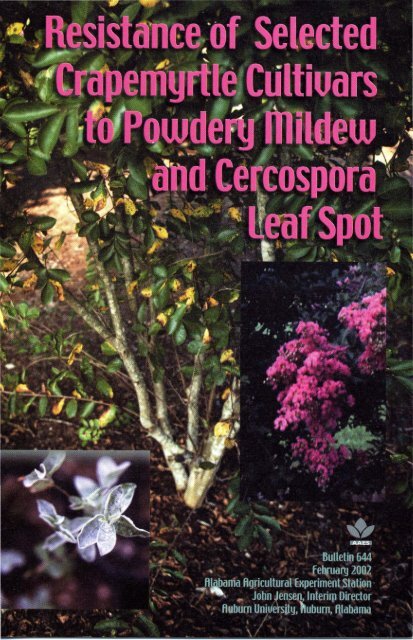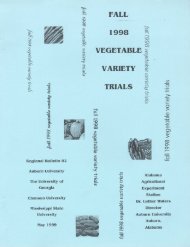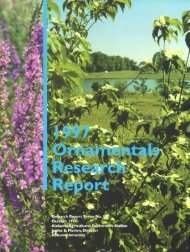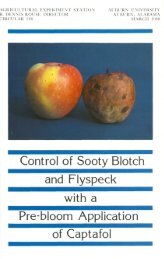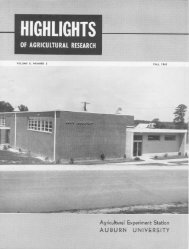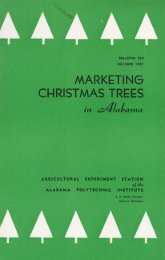Resistance of selected Crapemyrtle.pdf - Auburn University Repository
Resistance of selected Crapemyrtle.pdf - Auburn University Repository
Resistance of selected Crapemyrtle.pdf - Auburn University Repository
Create successful ePaper yourself
Turn your PDF publications into a flip-book with our unique Google optimized e-Paper software.
First Printing 1M, February 2002<br />
Find this and other publications on-line at www.ag.auburn.edu/resinfo/publications/<br />
Information contained herein is available to all persons without regard to race, color,<br />
gender, national origin, or religion.
REsiSTANCE OF SELECTED CRAPEMYRTLE<br />
CULTIV ARS TO POWDERY MILDEW AND<br />
CERCOSPORA LEAF SPOT<br />
AusTIN K. HAGAN, GARY J, KEEVER, CHARLES H. GILLIAM,<br />
J, DAVID WILLIAMS, AND GREG CREECH 1<br />
INTRODUCTION<br />
Brilliant fall color, handsome exfoliating bark, lush foliage, and<br />
large showy flower panicles have made crapemyrtle (Lagerstroemia indica)<br />
a fixture in landscapes and gardens across Alabama (17). Introduced<br />
from China in 1747, crapemyrtles range in size from small shrubs to sizable<br />
trees and are widely used in screens, hedges, mass plantings, or as<br />
accent or specimen plants. This highly versatile shrub and tree, which blooms<br />
throughout much <strong>of</strong> the summer, is best adapted to well-drained soils on<br />
sunny sites in USDA Hardiness Zones 7 to 9 (4,16). In the mid-1950s,<br />
Lagerstroemiafauriei was introduced from Japan and was later hybridized<br />
with L. indica to produce a number <strong>of</strong> highly desirable selections <strong>of</strong><br />
crapemyrtle. In addition, a number <strong>of</strong> improved cultivars <strong>of</strong> crapemyrtle<br />
(L. indica) have also been released into the nursery market.<br />
Powdery mildew (Erysiphe lagerstroemia) is the most widely recognized<br />
and common disease on crapemyrtle (1). Although this disease is<br />
not a serious threat to the health <strong>of</strong> established plants, a severe outbreak <strong>of</strong><br />
powdery mildew can greatly detract from the beauty <strong>of</strong> crapemyrtle in<br />
landscape plantings. Powdery mildew, which usually appears in late spring<br />
or early summer, is easily recognized by the appearance <strong>of</strong> white to buffcolored<br />
colonies <strong>of</strong> E. lagerstroemia on leaves, tender shoots, and bud scales<br />
on the blooms. On heavily mildewed crapemyrtle, twisting <strong>of</strong> the leaves,<br />
flower bud abortion, and shoot dieback may also be seen (1).<br />
Cercospora leaf spot (Cercospora lythracearum), which is not as<br />
well known as powdery mildew, may actually be more common than the<br />
latter disease (2). Circular to irregular brown spots, which first appear on<br />
mature leaves in late June to early July, are not noticeable until August. As<br />
1 Hagan is Pr<strong>of</strong>essor <strong>of</strong> Entomology and Plant Pathology; Keever, Gilliam, and Williams<br />
are Pr<strong>of</strong>essors <strong>of</strong> Horticulture, Creech is Research Associate <strong>of</strong> Horticulture; all at <strong>Auburn</strong><br />
<strong>University</strong>.
4<br />
ALABAMA AGRICULTURAL EXPERIMENT STATION<br />
the spots enlarge, the leaves turn yellow to bright red and quickly fall to the<br />
ground. Typically, leaf spotting and defoliation start on the lower limbs<br />
and gradually spread upward through the plant canopy until all but the<br />
youngest leaves at the shoot tips are lost. The heavy leaf shed associated<br />
with damaging disease outbreaks can greatly detract from the brilliant fall<br />
color display <strong>of</strong> leaf spot-susceptible crapemyrtle.<br />
Disease resistance is an effective, inexpensive, and pesticidefree<br />
method <strong>of</strong> producing and maintaining plantings <strong>of</strong> crapemyrtle in<br />
the nursery and landscape. As indicated above, a number <strong>of</strong> improved<br />
cultivars in the three crapemyrtle taxa (L. indica, L. fauriei, and L. indica<br />
x fauriei) were <strong>selected</strong> for superior horticultural characteristics<br />
as well as tolerance or resistance to powdery mildew<br />
(5,6,7,8,9,10,11,12,13,14). In recent studies, Knox et al. (16) and<br />
Windham et al. (18) did not see significant colonization <strong>of</strong> the leaves <strong>of</strong><br />
hybrid crapemyrtle cultivars by the powdery mildew fungus. In Louisiana,<br />
Holcomb (15) noted that several <strong>of</strong> the hybrid selections (L. indica<br />
x fauriei) and a number <strong>of</strong> cultivars <strong>of</strong> crapemyrtle (L. indica)<br />
were susceptible to powdery mildew and Cercospora leaf spot. In the<br />
same study, the hybrid cultivars 'Tonto', 'Tuscarora', and 'Catawba'<br />
were resistant to both powdery mildew and Cercospora leaf spot (15).<br />
In a landscape planting in <strong>Auburn</strong>, Alabama, selections in three<br />
crapemyrtle taxa (L. indica, L. fauriei, and L. indica x fauriei) were<br />
screened for their susceptibility to powdery mildew and Cercospora<br />
leaf spot.<br />
MATERIALS AND METHODS<br />
A field planting <strong>of</strong> 45 selections <strong>of</strong> crapemyrtle in the taxa L. indica,<br />
L. fauriei, and L. indica x fauriei was established on the Alabama<br />
Agricultural Experiment Station (AAES) unit on the campus <strong>of</strong> <strong>Auburn</strong><br />
<strong>University</strong>, Alabama (USDA Hardiness Zone 8a). Before planting, soil<br />
fertility and pH were adjusted according to the recommendations <strong>of</strong> a soil<br />
fertility assay <strong>of</strong> the <strong>Auburn</strong> <strong>University</strong> Soil Testing Laboratory. In March<br />
1993, bare-root liners were planted in full sun in a Marvyn loamy sand on<br />
eight-foot centers in rows spaced 12 feet apart. The test site was sloped<br />
slightly to the southeast. The experimental design was a randomized complete<br />
block with six, two-tree replications. A trickle irrigation system with
RESISTANCE OF SELECTED CRAPEMYRTLE CULTIVARS 5<br />
two emitters per tree was installed at the time <strong>of</strong> tree establishment, and the<br />
trees were watered as needed. Twice each spring, approximately six ounces<br />
<strong>of</strong> 13-13-13 analysis fertilizer was uniformly distributed around the base <strong>of</strong><br />
each plant. A tank-mix <strong>of</strong>Princep 4L and Surflan A.S. pre-emergent herbicides<br />
was applied at label rates in March 1996 and March 1997. Hand<br />
weeding and directed applications <strong>of</strong> label rates <strong>of</strong> Roundup Pro herbicide<br />
were used to control escape weeds. Alleys between the rows were periodically<br />
mowed. In 1995, all trees were mulched with two inches <strong>of</strong> aged pine<br />
bark. During the winters <strong>of</strong> 1995 and 1996, each tree was lightly pruned to<br />
enhance form and structure.<br />
Within two years <strong>of</strong> planting, the causal fungi <strong>of</strong> powdery mildew<br />
(E. lagerstroemia) and Cercospora leaf spot (C. lythracearum) were<br />
well established in this planting <strong>of</strong> crapemyrtle. Powdery mildew ratings<br />
were recorded on July 28, 1995: June 4, 1996: and June 25, 1997<br />
using a scale <strong>of</strong> 0 to 4 (0 = no disease, 1 = 1 to 25%, 2 = 26 to 50%, 3 =<br />
51 to 75%, and 4 = 76 to 100% <strong>of</strong> the leaves, shoots, and buds damaged<br />
or colonized by E. lagerstroemia). The severity <strong>of</strong> Cercospora leaf<br />
spot was evaluated on Septel)lber 15, 1995; September 4, 1996; and<br />
August 29, 1997 using the Barratt and Horsfall Rating System (1 = 0%,<br />
2 = 0 to 3%, 3 = 3 to 6%, 4 = 6 to 12%, 5 = 12 to 25 %, 6 = 25 to 50%,<br />
7 =50 to 75 %, 8 = 75 to 87%, 9 = 87 to 94%, 10 = 94 to 97%, 11 = 97<br />
to 100%, and 12 = 100% <strong>of</strong> the leaves exhibiting characteristic symptoms<br />
or prematurely lost due to this disease).<br />
RESULTS<br />
By mid-May each year, the typical fluffy white colonies <strong>of</strong> the powdery<br />
mildew fungus were seen on the young leaves and shoots <strong>of</strong> the mildew-susceptible<br />
crapemyrtle cultivars. Generally, the occurrence <strong>of</strong> powdery<br />
mildew peaked between mid-June and late July. The fungal colonies<br />
persisted on leaves <strong>of</strong> susceptible cultivars until early fall. Although symptoms<br />
<strong>of</strong> Cercospora leaf spot first appeared on highly susceptible cultivars<br />
as early as June, spotting <strong>of</strong> the leaves and premature leaf shed usually<br />
were not noticeable on most cultivars until mid-August to early September.<br />
Spotting <strong>of</strong> the leaves and leaf shed continued through the fall until the first<br />
hard frost in late October or early November.
RESISTANCE OF SELECTED CRAPEMYRTLE CULTIVARS 7<br />
TABLE 1. SuSCEPTIBILITY OF CRAPEMYRTLE (L. INDICA) CULTIVARS TO POWDERY<br />
MILDEW AND CERCOSPORA LEAF SPOT<br />
Blossom Growth Powdery mildew 2 Cercospora leafspot 3<br />
Cultivar color habit' 1995 1996 1997 1995 1996 1997<br />
L. indica<br />
Carolina Beauty Red LT 2.3 1.6 1.2 5.8 6.3 5.8<br />
Catawba Purple ST 0.7 0.1 1.2 3.6 4.6 3.0<br />
Centennial Spirit Red ST 1.6 0.0 0.8 2.2 4.8 5.0<br />
Cherokee Red SD 0.0 0.0 NR4 2.3 4.0 NR<br />
Country Red Red ST 2.8 2.5 0.9 4.0 4.6 5.0<br />
Glendora White White SD 0.4 0.4 0.5 2.3 3.7 3.8<br />
Gray's Red Red ST 2.2 0.8 1.0 3.5 3.9 4.3<br />
Hardy Lavender Lavender LT 1.1 1.1 1.8 4.2 5.1 5.0<br />
Majestic Beauty White SD 1.7 1.0 1.0 3.7 5.3 5.0<br />
Near East Light pink ST 0.3 0.0 1.3 5.0 5.4 4.7<br />
Orbin Adkins White ST 2.4 0.7 1.2 5.7 6.8 6.8<br />
Peppermint Lace Pink/ D 1.7 1.0 1.6 4.0 5.6 4.9<br />
white edges<br />
Potomac Pink ST 1.8 0.3 0.9 2.7 4.5 3.6<br />
Powhatan Purple ST 1.3 1.1 1.8 3.4 5.5 5.5<br />
Raspberry Sundae Deep red SD 3.1 1.5 1.5 4.6 5.7 5.3<br />
Regal Red Red ST 0.6 1.2 1.3 2.1 4.0 4.2<br />
Seminole Pink ST . 0.8 0.3 2.2 3.3 5.6 4.5<br />
Velma's Royal<br />
Delight Purple D 1.2 0.6 1.4 2.0 3.3 3.7<br />
William Toovey Pink/red ST 1.9 1.3 1.8 3.7 4.4 3.6<br />
Wonderful White White LT 2.4 1.5 1.3 5.0 6.8 6.8<br />
'D =dwarf form (3-5 feet), SD = semi-dwarf (5-10 feet), ST= small tree (10-20 feet), LT =large<br />
tree (20 feet or larger).<br />
2 Powdery mildew was rated on a scale <strong>of</strong> 0 to 4 where 0 = no disease, 1 = 1 to 25%, 2 = 26 to<br />
50%, 3 =51 to 75%, 4 = 76 to 100% <strong>of</strong> the leaves damaged or colonized E. lagerstroemia.<br />
3 Cercospora leaf spot was evaluated using the Barratt and Horsfall System: 1 = 0%, 2 = 0 to 3%,<br />
3 = 3 to 6%, 4 = 6 to 12%, 5 = 12 to 25 %, 6 = 25 to 50%, 7 =50 to 75%, 8 = 75 to 87%, 9 = 87<br />
to 94%, 10 = 94 to 97%, 11 = 97 to 100%, 12 = 100%.<br />
three years, the characteristic white colonies <strong>of</strong> the fungus E. lagerstroemia<br />
were not seen on the leaves, flower buds, or shoots <strong>of</strong> 'Sarah's Favorite',<br />
'Comanche', 'Osage', 'Acoma', 'Tonto', 'Souix', 'Lipan', or 'Natchez'.<br />
On the remaining hybrid crapemyrtle cultivars, as well as on L. fauriei<br />
'Fantasy', the incidence <strong>of</strong> powdery mildew was limited to a single or a<br />
few widely scattered colonies <strong>of</strong> the fungus on the leaves, tender shoots,<br />
and flower buds.<br />
Although most hybrid crapemyrtle selections are highly resistant<br />
to powdery mildew, only a handful were resistant to Cercospora leaf spot
8<br />
Fig. 1 Cottony white growth or hyphae <strong>of</strong> powdery<br />
mildew fungus on leaves <strong>of</strong> crapemyrtle.<br />
Fig. 3 In a Cercospora leaf spot infection, circular<br />
to irregular brown spots appear on the older<br />
leaves near the base <strong>of</strong> the plant. Later, these<br />
spotted leaves begin to turn yellow to bright red<br />
before they fall to the ground.<br />
Fig. 5 Cercospora leaf spot-susceptible<br />
crapemyrtles such as 'Acoma' may be heavily<br />
defoliated and have poor fall color.<br />
ALABAMA AGRICULTURAL EXPERIMENT STATION<br />
Fig. 2 Heavy powdery mildew outbreak on<br />
'Raspberry Sundae' crapemyrtle.<br />
Fig. 4 Symptoms <strong>of</strong> Cercospora leaf spot include<br />
yellowing and premature loss <strong>of</strong> the spotted<br />
leaves near the base <strong>of</strong> the tree or shrub.
RESISTANCE OF SELECTED CRAPE MYRTLE CUL TIVARS<br />
Fig. 6 Of the 45 selections <strong>of</strong> crapemyrtle<br />
screened, 'Fantasy' was the most disease<br />
resistant.<br />
Fig. 7 Other powdery mildew and Cercospora leaf<br />
spot resistant selections <strong>of</strong> crapemyrtle included:<br />
clockwise from top right (a) 'Tonto', (b)<br />
'Tuscarora', (c) 'Tuskegee', and (d) 'Velma's<br />
Royal Delight'.<br />
9
10<br />
ALABAMA AGRICULTURAL EXPERIMENT STATION<br />
(Table 2). Of the 22 selections <strong>of</strong> hybrid crapemyrtle, 'Tonto', 'Tuskegee',<br />
and 'Tuscarora' have the highest level <strong>of</strong> resistance to this disease. In each<br />
area, damage on these cultivars and L fauriei 'Fantasy' was confined to<br />
light, inconspicuous spotting <strong>of</strong> the leaves around the base <strong>of</strong> the plants.<br />
Light to moderate spotting <strong>of</strong> the leaves along with a low level <strong>of</strong> early leaf<br />
shed, as indicated by disease ratings <strong>of</strong> 2.5 to 3.8, was seen on 'Basham's<br />
TABLE 2. SuSCEPTIBILITY OF CRAPEMYRTLE (L, INDICA X FAURIEI ND L. FAURIEI)<br />
CuLTIVARS TO PowDERY MILDEw AND CERCOSPORA LEAF SPOT<br />
Blossom Growth -Powdery mildew 2 - Cercospora leafspot1<br />
Cultivar color habit' 1995 1996 1997 1995 1996 1997<br />
L. indica xfauriei<br />
Acoma White SD 0.0 0.0 0.1 5.3 6.3 6.2<br />
Apalachee Lavender ST 0.2 0.0 0.2 2.7 2.8 1.3<br />
Basham's Party Pink LT 0.2 0.2 0.4 2.8 2.5 1.7<br />
Pink<br />
Biloxi Light pink LT 0.4 0.3 0.8 4.4 5.3 4.0<br />
Caddo Bright pink SD 0.0 0.0 0.0 2.4 2.9 4.6<br />
Choctaw Bright pink LT 0.0 0.1 0.3 4.5 4.6 3.5<br />
Comanche Coral ST. 0.0 0.0 0.4 5.6 6.6 4.9<br />
Hopi Pink SD 0.2 0.0 1.7 3.9 5.7 5.4<br />
Lipan Lavender ST 0.3 0.0 0.0 2.9 5.1 2.6<br />
Miami Dark pink LT 0.1 0.0 0.7 3.5 4.7 3.2<br />
Muskogee Lavender LT 0.2 0.0 0.6 4.7 4.8 4.2<br />
Natchez White LT 0.0 0.1 0.0 4.3 4.6 2.6<br />
Osage Light pink ST 0.0 0.0 0.4 2.8 4.0 1.3<br />
Pecos Pink SD 0.4 0.1 1.3 2.8 5.1 2.6<br />
Sarah's Favorite Pink LT 0.0 0.0 0.1 3.5 3.8 3.3<br />
Souix · Dark pink ST 0.1 0.0 0.0 4.3 5.2 1.3<br />
Tonto Red SD 0.1 0.0 0.0 2.3 1.3 1.2<br />
Tuscarora Coral pink LT 0.5 0.0 0.4 1.7 2.4 1.8<br />
Tuskegee Dark pink ST 0.1 0.4 0.2 1.8 1.5 1.3<br />
Wichita Lavender LT 0.3 0.0 0.8 2.8 3.6 2.6<br />
Yuma Lavender SD 0.4 0.0 0.4 4.9 5.0 5.2<br />
Zumi Lavender SD 1.3 0.3 1.8 4.8 4.4 3.5<br />
L. fauriei<br />
Fantasy White LT 0.4 0.0 0.2 1.4 1.1 1.7<br />
'D = dwarf form (3-5 feet), SD = semi-dwarf (5-10 feet), ST = small tree (10-20 feet), LT =<br />
large tree (20 feet or larger).<br />
2 Powdery mildew was rated on a scale <strong>of</strong> 0 to 4 where 0 = no disease, 1 = 1 to 25%, 2 = 26 to<br />
50%, 3 =51 to 75%, 4 = 76 to 100% <strong>of</strong> the leaves damaged or colonized E. lagerstroemia.<br />
3 Cercospora leaf spot was evaluated using the Barratt and Horsfall System: 1 = 0%, 2 = 0 to 3%,<br />
3 = 3 to 6%, 4 = 6 to 12%, 5 = 12 to 25%, 6 = 25 to 50%, 7 =50 to 75%, 8 = 75 to 87%, 9 = 87<br />
to 94%, 10 = 94 to 97%, 11 = 97 to 100%, 12 = 100%.
RESISTANCE OF SELECTED CRAPEMYRTLE CULTIVARS 11<br />
Party Pink', 'Apalachee', and 'Wichita'. Conversely, the heaviest spotting<br />
<strong>of</strong> the leaves and premature defoliation were noted in at least two <strong>of</strong> three<br />
years on 'Acoma' and 'Comanche'. Cercospora leaf spot ratings <strong>of</strong> 5.0 or<br />
higher were recorded in at least one year for another five cultivars <strong>of</strong> hybrid<br />
crapemyrtle.<br />
DISCUSSION<br />
<strong>Resistance</strong> to powdery mildew was one <strong>of</strong> the major selection criteria<br />
used to identify clones <strong>of</strong> hybrid crapemyrtle for release as part <strong>of</strong> the<br />
U.S. National Arboretum breeding program (5, 6, 7, 8, 9, 10, 11, 12, 13,<br />
14). Beginning with 'Natchez' and 'Muskogee', a total <strong>of</strong>22 hybrid cultivars<br />
have been released (7,8,9,10,11,12,13,14 ). <strong>Resistance</strong> <strong>of</strong> the cultivars<br />
<strong>of</strong> hybrid crapemyrtle and L. fauriei 'Fantasy' to powdery mildew is<br />
far superior to that shown by the selections <strong>of</strong> L. indica. With the exception<br />
<strong>of</strong> 'Zuni', 'Pecos', and 'Hopi', the cultivars <strong>of</strong> hybrid crapemyrtle proved<br />
highly resistant or immune to powdery mildew. Typically, similar results<br />
have been obtained when the releases from the U.S. National Arboretum<br />
were evaluated in the field (15,16,18).<br />
Many cultivars <strong>of</strong> crapemyrtle (L. indica) were moderately or highly<br />
susceptible to powdery mildew, while others like 'Glendora White', and<br />
'Cherokee' were highly resistant to nearly immune to this disease. Of the<br />
five mildew tolerant cultivars <strong>of</strong> L. indica released by the U.S. National<br />
Arboretum, light to moderate mildew development was recorded in at<br />
least one year on 'Powhatan', 'Seminole', 'Potomac', and 'Catawba'. As<br />
observed in previous trials, 'Wonderful White' (18), 'Carolina Beauty' (16),<br />
and 'Seminole' (16) were highly susceptible to powdery mildew.<br />
Far more cultivars <strong>of</strong> hybrid crapemyrtle were resistant to powdery<br />
mildew than to Cercospora leaf spot. In Louisiana, Holcomb ( 15) also noted<br />
similar differences in the sensitivity <strong>of</strong> cultivars <strong>of</strong> hybrid crapemyrtle to<br />
Cercospora leaf spot. In both the AAES and Louisiana studies, 'Tonto',<br />
'Tuskegee', and 'Tuscarora' were the most Cercospora leaf spot and powdery<br />
mildew resistant. A few cultivars <strong>of</strong> L. indica along with L. fauriei<br />
'Fantasy' also suffered relatively light damage from Cercospora leaf spot<br />
and powdery mildew.<br />
Surprisingly, compared to powdery mildew, Cercospora leaf spot<br />
proved to be an equally if not more, damaging disease on two <strong>of</strong> the three<br />
crapemyrtle taxa. Previously, powdery mildew garnered far more atten-
12<br />
ALABAMA AGRICULTURAL EXPERIMENT STATION<br />
tion from pr<strong>of</strong>essionals than did Cercospora leaf spot. Cultivars resistant<br />
to powdery mildew were "found in all three taxa <strong>of</strong> crapemyrtle. Among<br />
the cultivars <strong>of</strong> L. indica, 'Glendora White' and 'Cherokee' were among<br />
the most disease resistant. Hybrid crapemyrtle cultivars highly resistant to<br />
powdery mildew were 'Tonto', 'Tuskegee', 'Tuscarora', 'Basham's Party<br />
Pink', 'Apalachee', and 'Caddo'.<br />
The one cultivar <strong>of</strong> L.fauriei, 'Fantasy', also suffered little damage<br />
from either disease. When horticultural characteristics and disease resistance<br />
were both considered, the superior white-flowered cultivars were<br />
'Natchez', 'Sarah's Favorite', and 'Fantasy', while 'Basham's Party Pink',<br />
'Tuscarora', and 'Tuskegee' were the top rated pink-flowered crapemyrtles<br />
(3). All <strong>of</strong> the above crapemyrtles can be easily produced in a nursery or<br />
maintained in a landscape without protective fungicide treatments. Those<br />
cultivars that were badly damaged by either powdery mildew, Cercospora<br />
leaf spot, or in some cases both diseases, may not suffer serious damage in<br />
the nursery but would be poor choices for commercial and residential landscapes<br />
across Alabama.
RESISTANCE OF SELECTED CRAPEMYRTLE CULTIVARS 13<br />
REFERENCES<br />
1. Alfieri, S. A. 1969. Powdery mildew <strong>of</strong> crapemyrtle. Fla. Dept.<br />
<strong>of</strong> Agric. Cons. Ser. Plant Path. Cir. 83. 2 pp.<br />
2. Alfieri, S. A. 1976. Cercospora leaf spot <strong>of</strong> crapemyrtle,<br />
Lagerstroemia indica. Fla. Dept. <strong>of</strong> Agric. Cons. Ser. Plant Path<br />
Cir. 171. 2 pp.<br />
3. Creech, G., C. Gilliam, G. Keever, A. Hagan, J. Graverman, R.<br />
Brantley, and D. Williams. 1999. <strong>Crapemyrtle</strong> cultivar performance<br />
in Alabama. Proc. Southern Nursery Assoc. Res. Conf.<br />
44:489-491.<br />
4. Dirr, M.A. 1998. Manual <strong>of</strong> Woody Landscape Plants: Their<br />
identification, ornamental characteristics, culture, propagation, and<br />
uses, 5th Edition. Stipes Publishing Co. Champaign, IL. 1187 pp.<br />
5. Egolf, D. R. 1967. Four new Lagerstroemia indica cultivars<br />
(Lythraceae). Baileya 15:7-13.<br />
6. Egolf, D. R. 1970. 'Cherokee' and 'Seminole'- two new cultivars<br />
<strong>of</strong> Lagerstroemia indica (Lythraceae). Baileya 17:1-5.<br />
7. Egolf, D. R. 1981. 'Muskogee' and 'Natchez' Lagerstroemia.<br />
HortScience 16:576-577.<br />
8. Egolf, D. R. 1981. 'Tuscarora' Lagerstroemia. HortScience<br />
16:788-789.<br />
9. Egolf, D. R. 1986. 'Tuskegee' Lagerstroemia. HortScience<br />
21:1078-1080.<br />
10. Egolf, D. R. 1986. 'Acoma', 'Hopi', 'Pecos', and 'Zumi'<br />
Lagerstroemia. HortScience 21:1250-1252.<br />
11. Egolf, D. R. 1987. 'Biloxi', 'Miami' and 'Wichita'<br />
Lagerstroemia. HortScience 22:33-338.<br />
12. Egolf, D. R. 1987. 'Apalachee', 'Comanche', 'Lipan', 'Osage',<br />
'Souix', and 'Yuma' Lagerstroemia. HortScience 22:674-677.
14<br />
ALABAMA AGRICULTURAL EXPERIMENT STATION<br />
13. Egolf, D. R. 1990 . . 'Caddo' and 'Tonto' Lagerstroemia.<br />
HortScience 25:585-587.<br />
14. Egolf, D. R. 1990. 'Choctaw' Lagerstroemia. HortScience<br />
25:992-993.<br />
15. Holcomb, G. E. 1997. Reaction <strong>of</strong> crapemyrtle cultivars to<br />
Cercospora leaf spot and powdery mildew. Biological and Cultural<br />
Tests for Control <strong>of</strong> Plant Diseases. 12:56.<br />
16. Knox, G. W., R. F. Mizell, III, and D. 0 . Chellemi. 1992. Susceptibility<br />
<strong>of</strong> crapemyrtle cultivars to crapemyrtle aphid and<br />
powdery mildew. Proc. Southern Nursery Assoc. Res. Conf.<br />
37:340-342.<br />
17. Williams, D., K. Tilt, and S. Valenti-Windsor. 1998. Common<br />
<strong>Crapemyrtle</strong>. Ala. Coop. Ext. Sys. Cir. ANR-1083. 6 pp.<br />
18. Windham, M. T., W. T. Witte, R. J. Sauve, and P. C. Flanagan.<br />
1995. Powdery mildew observations and growth <strong>of</strong> crapemyrtle in<br />
Tennessee. HortScience 30:813.
Alabama's Agricultural Experiment Station<br />
AUBURN UNIVERSITY<br />
With an agricultural<br />
research unit in every<br />
major soil area,<br />
<strong>Auburn</strong> <strong>University</strong><br />
serves the needs <strong>of</strong> field<br />
crop, livestock, forestry,<br />
and horticultural<br />
producers in each<br />
region in Alabama.<br />
Every citizen <strong>of</strong> the<br />
state has a stake in this<br />
research program, since<br />
any advantage from new<br />
and more economical<br />
ways <strong>of</strong> producing and<br />
handling farm products<br />
directly benefits the<br />
consuming public.<br />
Research Unit Identification<br />
* Alabama A&M <strong>University</strong><br />
'{;:( E. V. Smith Research Center, Shorter.<br />
@ Main Agricultural Experiment Station, <strong>Auburn</strong>.<br />
1. Tennessee Valley Research and Extension Ce nter, Belle Mina.<br />
2. Sand Mountain Research and Extension Center. Crossville.<br />
3. North Alabama Horticullure Station, Cu llman.<br />
4. Upper Coastal Plain Research Station, Winfield .<br />
5. Chilton Area Horticulture Station. Clanton.<br />
6. Piedmont Research Station. Camp Hill.<br />
7. Prattville Experiment Field. Prattville.<br />
8. Black Belt Research and Extension Center, Marion Junction.<br />
9. Lower Coastal Plain Research Station, Camden.<br />
10. Monroeville Experiment Field, Monroeville.<br />
11 . Wiregrass Research and Extension Center. Headland.<br />
12. Brewton Experiment Field, Brewton.<br />
13. Ornamental Horticulture Station. Spring Hill.<br />
14. Gull Coast Research and Extension Center, Fairhope.


